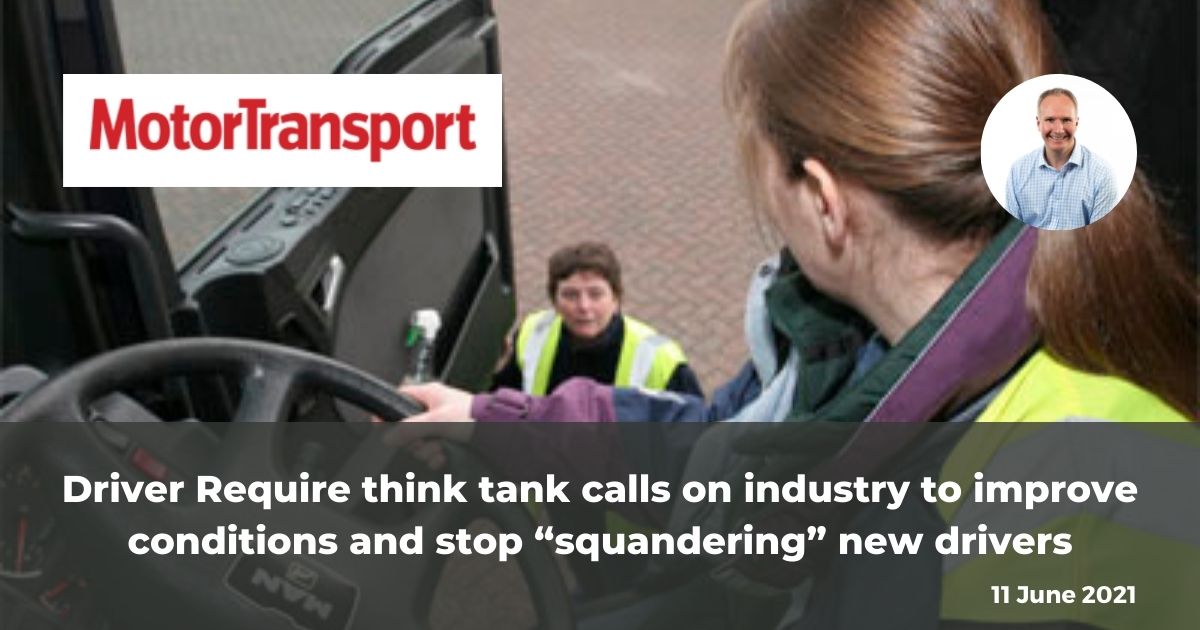Driver Require think tank calls on industry to improve conditions and stop “squandering” new drivers
New Driver Require Think Tank report on the driver shortage mentioned in MotorTransport

An industry think tank put together by HGV driver recruitment firm Driver Require believes that the key to solving the long-term shortage of drivers lies in stopping existing drivers leaving the industry as well as recruiting and training more new drivers.
The first report from the think tank, led by Driver Require CEO Kieran Smith, pictured, and including leading hauliers, training providers and industry bodies, estimated that since the beginning of the pandemic the HGV driver pool has contracted by 22,000 and that, as lockdown restrictions have been lifted, this translates into a shortage of 22,000 HGV drivers, which could increase to 50,000 if demand grows to exceed the pre-pandemic demand of 300,000.
The fact that the BBC is now reporting the HGV driver shortage on its flagship Radio 4 Today programme highlights the seriousness of the situation which may just make the government sit up and take notice.
“This indicates the severity of the issue,” says Smith. “The Financial Times has also been covering the subject. Our estimate is real not just a made up or inflated number.
“In the first quarter of 2020, prior to the pandemic, the shortage was not really evident largely due to European drivers stepping in and British drivers being more flexible; we even had spare drivers. The figure of 22,000 is a conservative estimate and one we would historically have been able to cope with by calling on European drivers.
“But we alienated them with Brexit and put laws in place saying they can’t come back and work legally.”
Driver Require’s second report, ‘The answer to the UK’s HGV driver shortage’, due to be published soon, seeks to come up with actions industry and government need to take to halt the “squandering” of qualified drivers and restart the pipeline of new drivers that was shut off in the pandemic.
The report’s key conclusions are:
- We recognise the great efforts of the organisations, such as Road to Logistics and Think Logistics, who have successfully attracted candidates to maintain a constant supply to the HGV driver training schools
- The consequence has been a steady flow of up to around 30,000 new HGV test passes per year, but this has been offset by 10,000 per year retiring and a further 20,000 quitting HGV driving for a living
- Specifically, over the past decade we have trained around 200,000 HGV drivers under the age of 40, yet the under-40 HGV driver pool remained steadfastly at 67,000
- This equates to around 150,000 new HGV drivers below the age of 40 who have left the UK HGV driver pool to pursue other careers. It is shocking that all the good work attracting candidates is squandered by a lack of action to retain these drivers in the HGV workforce after they have passed their HGV test
- We also have a plug of ageing drivers passing into retirement resulting in a net depletion of the HGV driver workforce of around 6,000 drivers per annum
- The severity of the issue could worsen as we better understand the rate of departure of the EU HGV driver contingent
While the report recognises the government’s free market approach to HGV drivers, it lists actions the think tank wants from government and regulatory bodies:
- Provide funding for haulage operators and HGV training schools, or other specially created entities, to “nurture” newly qualified drivers, possibly integrated or associated with the HGV Apprenticeship programme
- Get a much better understanding of why HGV drivers have ceased working as a driver for a living, then develop targeted initiatives to bring back certain groups of HGV licence holder into driving for a career
- Pay the cost of Driver CPC training, lost wages and a refresher course for returning HGV licence holders, perhaps through a network of approved HGV driver training schools.
- Pay new and returning HGV drivers the first few weeks so that haulage companies engaging these drivers are subsidised for the time they spend getting them up to standard
- It is still worth trying to get HGV drivers declared as a ‘shortage occupation’, but this may not be as effective as we hope, given that the driver shortage on the continent is not getting any better
“In the short term, the solution has to be around government funding to get people who have a licence but aren’t driving to come back in,” says Smith. “The market will push pay rates up and that is already happening. Agency rates are up 15% to 20% since April and it is not unusual to have annualised salaries of £40,000 to £45,000 for a Class 1 supermarket driver and it might go higher.
“Drivers deserve to be compensated and recognised for the difficult conditions and high level of responsibility they bear in their role. Pay isn’t everything and the most important thing in any job is respect and recognition, but unfortunately many drivers don’t get that.”
Other actions recommended by the report include:
- Bring the RHA, Logistics UK and haulage operators together in an initiative to identify, publicise and deploy best practice examples of HGV driver engagement and retention initiatives
- Negotiate with insurers to reduce limitations on the age of HGV drivers
- Get a much better understanding from the HGV licence holders who did not take up, or gave up driving for a living, as to why they quit driving
- Offer PSV drivers the ability to cheaply and quickly convert their Category D licence into a Category C licence to provide a quick supply of HGV drivers from the pool of under-employed bus and coach drivers
“The size of our HGV driver pool didn’t change significantly in the eight years prior to the pandemic,” says Smith. “Every year we put 20,000 new passes aged under 45 into the sector. But the age group between 20 and 45 has not increased because every year for the past 10 years 20,000 of them leave the industry. New HGV passes come in, take one look around and say ‘that’s not for me’. We need to see improvements in HGV working conditions to the point where a career as an HGV driver is attractive to people from all backgrounds.
“We have to fix the HGV working environment to keep more people in the industry.”
Read the full article in MotorTransport
Google Reviews
-
 Dave GallacherGood range of jobs available, decent rates of pay. Always able to get in contact with the office or someone on call with good knowledge and understanding of the job or role sent to. Never had an issue with pay, easy timesheet process
Dave GallacherGood range of jobs available, decent rates of pay. Always able to get in contact with the office or someone on call with good knowledge and understanding of the job or role sent to. Never had an issue with pay, easy timesheet process -
(1).png?r=a2-s120.120-o) Ionel Lucian DinicaVery easy to find work , very nice and kind staff, all details explained very easy. Highly recommended.
Ionel Lucian DinicaVery easy to find work , very nice and kind staff, all details explained very easy. Highly recommended. -
 Catalin SirgheA reliable and efficient agency. I’ve had a positive experience with Driver Require. They have consistently paid on time and have never cancelled a shift. The communication is excellent. If you’re looking for a reliable agency that values its drivers, Driver Require is a great choice.
Catalin SirgheA reliable and efficient agency. I’ve had a positive experience with Driver Require. They have consistently paid on time and have never cancelled a shift. The communication is excellent. If you’re looking for a reliable agency that values its drivers, Driver Require is a great choice.
